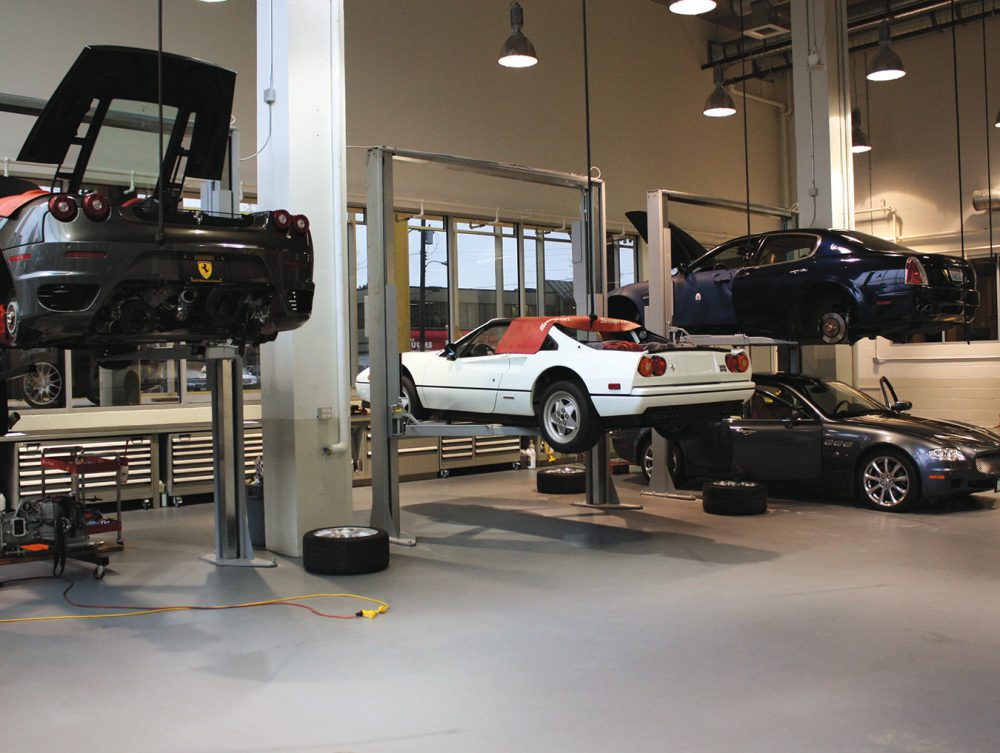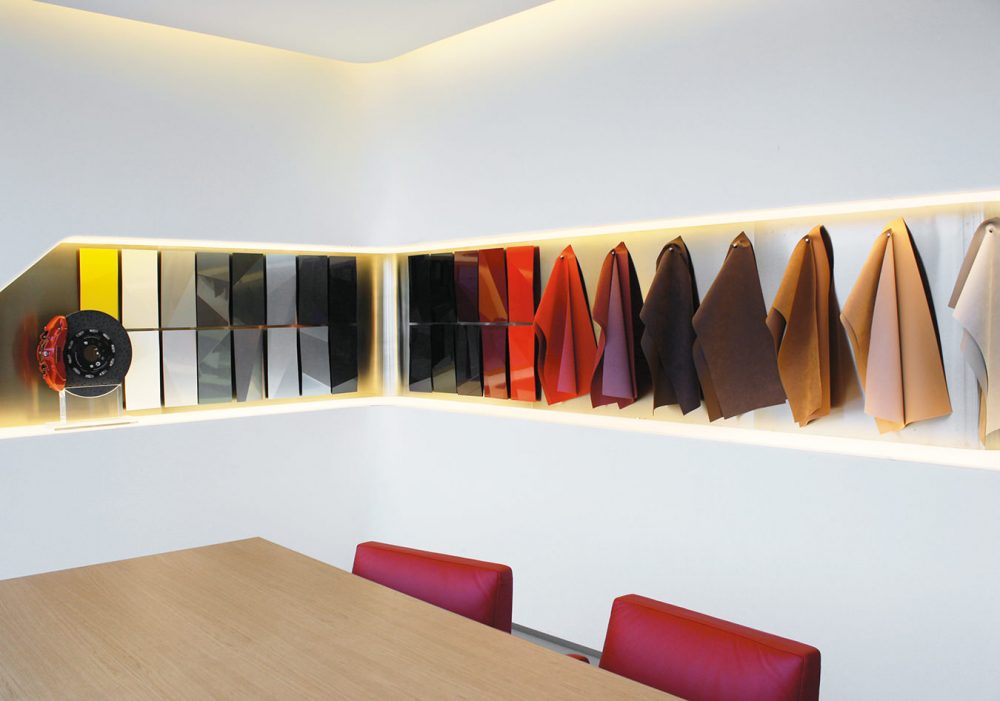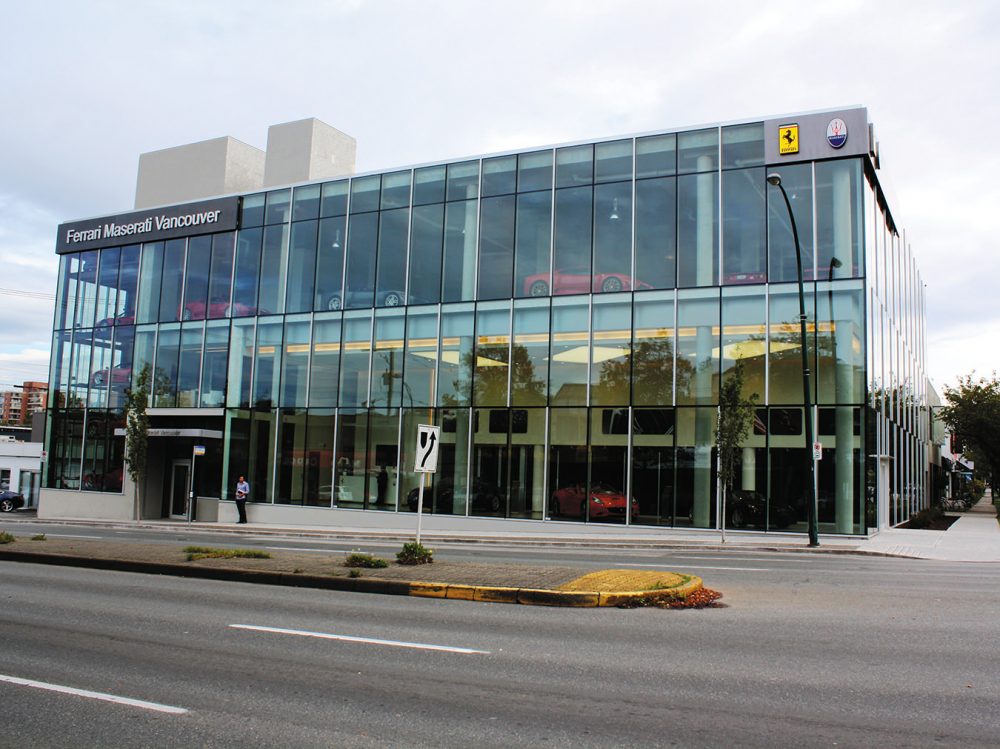Of all the words one might employ to describe a Ferrari—bold, dramatic, sexy, magnificent (to highlight only a few possibilities)—invisible would likely not be on the list. Ironic, then, that it is among the first that come to mind when describing Vancouver’s new Ferrari dealership at the corner of West 3rd Avenue and Burrard. If it weren’t for the signage beaming down from the third story, you might not see the building at all. You’d be far too busy looking through the glass walls, your gaze held, vise-like, on that which lies inside.
And that, in the mind of master architect James Cheng, is exactly as it should be. “The vision is actually very simple,” he declares with measured confidence. “Make the building disappear.”
As the mind behind some of the city’s most iconic buildings—the 62-storey Shangri-La Hotel, the Shaw Tower, the Fairmont Pacific Rim—Cheng isn’t usually in the business of not getting noticed. Quite the opposite: over the past 33 years, he and his eponymous firm have put Vancouver on the architectural map, making a substantial contribution to Vancouver’s reputation as the “city of glass”. That reputation is almost certain to increase with his newest creation. “We wanted to make a minimalist glass box,” he says. “When people look at the building, they see right through it, and then the first things that catch their eyes are the cars. The building becomes secondary.”
Secondary, perhaps, but by no means second-rate. While the dealerships of other luxury brands that cluster along the south end of the Burrard Street Bridge are little more than glorified warehouses, Ferrari’s transcends such utilitarianism. The floor-to-ceiling glass walls speak of simple, stylish elegance, and place the building firmly within the city’s signature architectural style. Inside, the look is tastefully minimalist, with polished concrete floors, artfully exposed lighting and mechanical fixtures and white decor reinforcing a hip, neo-industrial aesthetic. All of it bears the signs of careful calculation intended to eliminate distractions and focus the visitor’s attention on the beauty displayed on the showroom floor.
“Millions of children dream about one day driving a Ferrari. This dealership seems to me such a fantastic toy store. From outside, you pass by, it calls you in, just to touch these amazing toys.”
Such sleight of hand may be easy for the illusionist, but it is decidedly more difficult for the architect. “To be a minimalist is the hardest, because nothing can go wrong,” Cheng says. While crown moulding and drop ceilings can hide design flaws and contractor mishaps in traditional buildings, the see-through style offers no such luxury. “Every corner, every joint has to meet up perfectly, because you have no way to hide it,” Cheng points out. “It’s almost like the joint of a car. The reveal lines—they have to be perfect. That’s the kind of attention to detail and quality [that] permeates throughout the whole dealership.”
And it’s easy to see. Example: the glass-enclosed display elevator on the building’s northwest corner. By suspending four iconic Ferrari models above street level, visitors can observe the quality implicit in the Ferrari brand from all angles. The result is an installation of automotive art. Or take the open-concept service garage, visible from both the showroom and the street. “Most Ferrari owners are—how should I say it—a unique group of people,” Cheng opines. “They’re very proud of their cars, and they enjoy seeing people work on their cars.” In this respect, watching a Ferrari technician’s careful labour is just one more experience of the brand. “It makes a connection to the people who are actually working on the cars,” Cheng says. “It demonstrates there’s nothing to hide. Everything is open, accessible, and the quality shows itself.”
It’s that message of superlative quality that has led Matteo Mattiacci, president of Ferrari North America, to sing the praises of the Vancouver dealership. “The design of a dealership has to express the DNA of the brand, first of all,” Mattiacci says. “In this case, the architecture matches perfectly the purpose of our business. At the same time, I think it is a big statement we believe [in] the Vancouver market.”
Beyond the marketing strategy, Mattiacci says the building has also captured something essential about Ferrari—something that doesn’t necessarily show up on blueprints or brand guidelines. “Millions of children dream about one day driving a Ferrari,” Mattiacci says proudly. “This dealership seems to me such a fantastic toy store. From outside, you pass by, it calls you in, just to touch these amazing toys.”
It beckons, too, to the child at heart. The master architect’s favourite toy? The 458 Italia, a triumph of both design and engineering. “That’s what I like about Ferraris,” Cheng explains with a smile. “They don’t hold back; they try to improve with every generation.” A good philosophy for any business, including architecture. Cheng nods in agreement. “Same theory, same principles.”











